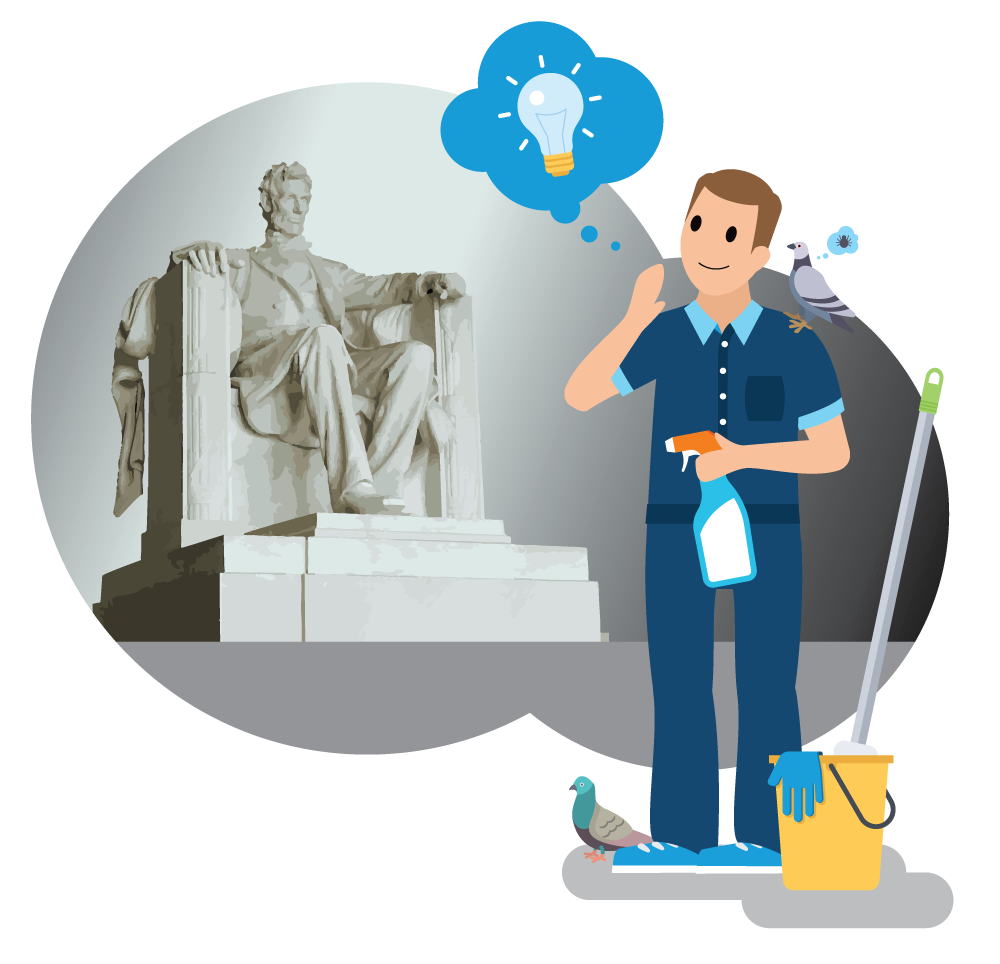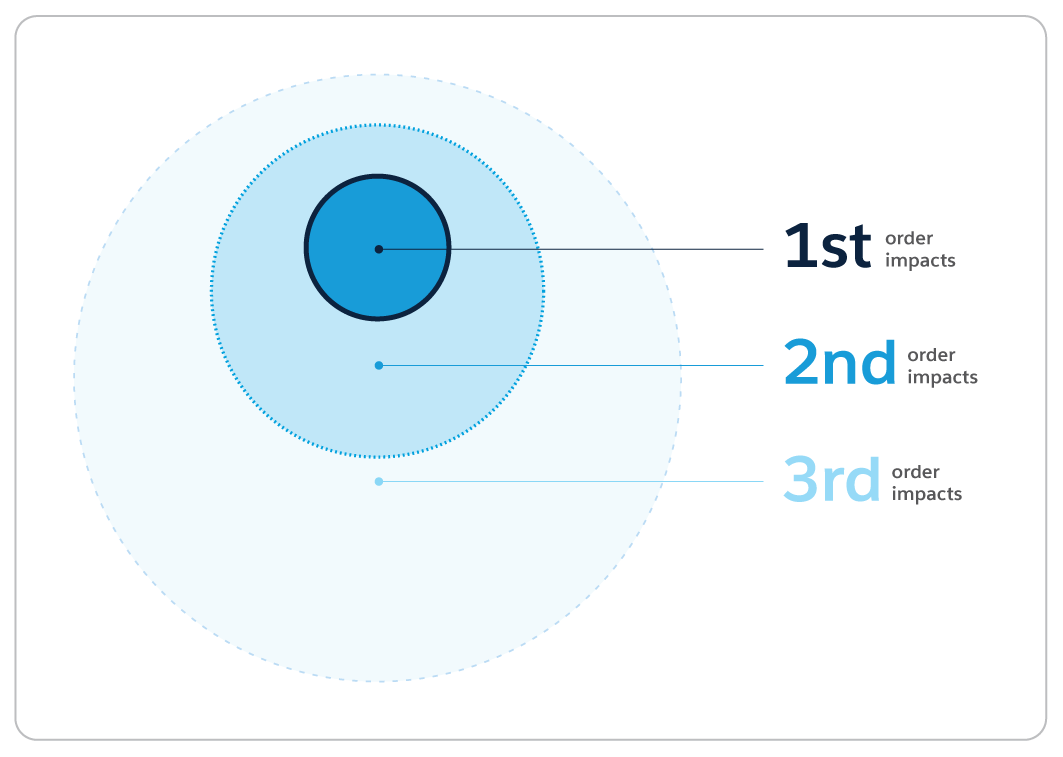Document Assumptions and Impact
Learning Objectives
After completing this unit, you’ll be able to:
- Lead a team through the Five Whys exercise to uncover the root cause of the problems you’re seeking to solve.
- Assemble diverse teams to assess the different impacts and consequences of your designs.
As you synthesize the inputs from your research, create journey maps of your users' experience, incorporate stakeholder feedback, and begin to consider what it is possible to design, it’s important to pay attention to the assumptions being made by our teams.
Sustainable design requires us to question and change business-as-usual product strategies and business-as-usual designs. Business “remains usual” because the assumptions at its core are rarely questioned. In this unit, you learn some simple, collaborative tools to help teams identify assumptions and discuss ways to challenge them for the benefit of your users, society, and the planet.
And here is a critical tip for these collaborative exercises: The more diverse your team is in terms of varied life experiences, the more impactful all of these exercises will be. Diversity is a powerful design amplifier because the more perspectives you have in the room, and the more you encourage people to share their diverse views, the richer, deeper, and more widely applicable your design will be.
Ask the Five Whys
Sustainability requires that we do things differently and to look more deeply at the causes and challenges we are trying to solve.
One of the reasons it's so hard to create new ideas and ways of working is that we, our teams, and our workplaces share assumptions about what can and cannot change. Often these assumptions are so embedded in the work culture that we can’t even see them. We never bother to ask why we have them or what is at the root cause of problems we are trying to solve.
The Five Whys were developed by Sakichi Toyoda, the founder of Toyota Industries. It’s a simple way to drill down to the root cause of a problem by asking Why? five times.
The classic business school example of the Five Whys goes like this:

Problem: The marble of the Lincoln Memorial is rapidly deteriorating. Restoration will be both expensive and risky.
Why #1–Why is the monument deteriorating?
Because we use harsh chemicals to clean it.
Why #2–Why do we use harsh chemicals?
To deal with the bird droppings.
Why #3–Why do we have so many bird droppings?
The birds come to eat the many spiders in the rotunda.
Why #4–Why are there so many spiders?
The spiders are there to catch the insects drawn to the monument at dusk.
Why #5–Why are insects drawn to the monument at dusk?
Because our nighttime lighting attracts them.
Solution: Change how the Lincoln Memorial is lit at night to keep from attracting insects.
Run a 5 Why Exercise
You can run a 5 Why exercise in 3 steps.
- Assemble a team.
- Define a clear sustainability challenge, such as:
- We aren’t on track to meet our zero-waste goals.
- Our efforts to increase environmental performance have stalled in XYZ region.
- Ask Why? Ask Why four more times.
Uncover Orders of Impact
So much of sustainable design is about simply widening the range of what we consider relevant to the experiences we’re designing. Designers are problem-solvers and solution-finders by nature. Sustainable design can often be about turning this natural tendency to problem solve toward a broader problem set.
The orders of impact exercise is an exercise to help broaden your perspective. It asks you to think about the impacts of your products in the world. But you go beyond just considering the first order of impact and ask what second- and third-order impacts your designs might have.
First-order impacts are the direct/intended impacts of a design decision or product: If we sell this product, consumers will be happy and our revenue will increase.
Second-order impacts are the consequences that might arise from the first-order impacts: Our consumers’ health will be impacted in this way (negative or positive).
Third-order impacts are the consequences of those consequences: If our consumers’ health is impacted, they may change their behavior in these ways… or: If our consumers’ health is impacted, the overall health of their community will be impacted in these ways...
 The order of impact exercise: a simple invitation to your team to consider the rippling effects and impacts of your design decisions.
The order of impact exercise: a simple invitation to your team to consider the rippling effects and impacts of your design decisions.
Run an Orders of Impact Exercise
With your team:
- Draw three concentric circles on a whiteboard or a digital space.
- Consider the experience/product you’re designing.
- Ask what are the first-order impacts of your design? These might include:
- The purchases and subsequent uses you hope to create.
- The impact on the business: revenue, costs incurred, and so on.
- Ask what are the second-order impacts of your design? These might include:
- The social or environmental effects of the uses of your product.
- Impacts on people/communities other than your immediate customer.
- What are the third-order impacts of your design? These might include:
- The ripple effects of second order impacts over time.
- The effects your industry as a whole has on the world.
- Consider the implications. Ask how can we amplify the positive impacts and mitigate the negative impacts?
The Consequence Scan
The consequence scan is similar to the orders of impact exercise—same objective, slightly different vocabulary. Try both and keep using the one that works with your team.
Consequence scanning asks, “What are the positive and negative consequences of our designs?” and sets up a brainstorm on how to amplify the positive and intentionally minimize the negative.
- Intended consequences are the things you want to make happen. These include your project requirements. Try to extend them to include the negative and positive impacts beyond the direct consequences to your business and your customer.
- Unintended consequences are things that might happen outside your core intentions. These include consequences you may not consider at first. Discuss how your product or service can be used in ways you don’t intend, and its unintended ripple effects.
Run a Consequence Scan Exercise
With your team:
- Consider your design and ask, What are the intended consequences of our design?
- Ask, What might the unintended consequences be?
- Ask, How can we mitigate the unintended negative consequences?
Like so much in design, designing more sustainably is about asking the right questions: What assumptions are inherent in our business-as-usual approach? What would happen if we challenged those assumptions? Why do we do things the way we do them? Why do we do those things the way we do them? Can we do them differently? The simple team exercises in this unit give you and your team ways to begin to have these conversations and to put our designs on a path to sustainability.
The next unit on green UX provides additional questions we can ask in order to make our user experience designs more sustainable.